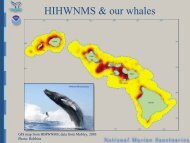The First International Conference on Marine Mammal Protected Areas
The First International Conference on Marine Mammal Protected Areas
The First International Conference on Marine Mammal Protected Areas
Create successful ePaper yourself
Turn your PDF publications into a flip-book with our unique Google optimized e-Paper software.
Summaries of Presentati<strong>on</strong>s:<br />
Ship strikes in the Mediterranean Sea<br />
Sim<strong>on</strong>e Panigada<br />
Globally, evidence of ship strikes has been reported for 11 species of large whales, with<br />
the fin whale the species hit most frequently. Based <strong>on</strong> data from stranding networks and<br />
historical and anecdotal sources in the Mediterranean, there are 281 records of dead fin<br />
whales from 1971 to 2001, of which 42 (14.9%) were killed by a vessel collisi<strong>on</strong>. More<br />
than 85% of the reported ship strikes occurred in or adjacent to the Pelagos Sanctuary<br />
for <strong>Marine</strong> <strong>Mammal</strong>s, an MPA characterized by very high levels of ship traffic and a high<br />
density of fin whales. Ship strike rates are unquesti<strong>on</strong>ably underestimated because not all<br />
collisi<strong>on</strong> events are reported. <str<strong>on</strong>g>The</str<strong>on</strong>g> rates are nevertheless high enough to justify<br />
management and mitigati<strong>on</strong> efforts, e.g., ship traffic c<strong>on</strong>trol measures, to reduce<br />
accidents and keep mortality rates at sustainable levels.<br />
Reducing humpback whale disturbance and risk of ship strike using vessel speed and course restricti<strong>on</strong>s<br />
in Glacier Bay, Alaska<br />
Christine Gabriele<br />
Glacier Bay Nati<strong>on</strong>al Park is a glacial fiord in southeastern Alaska that serves as a<br />
summer feeding ground for humpback whales, which are listed under the U.S.<br />
Endangered Species Act. Park regulati<strong>on</strong>s aim to reduce whale disturbance and the risk<br />
of whale-vessel collisi<strong>on</strong>s. Vessel traffic in park waters is mainly tourism-related and<br />
c<strong>on</strong>sists of motor vessels ranging from 300 m cruise ships to 5 m fishing or recreati<strong>on</strong>al<br />
craft. Whale protecti<strong>on</strong> regulati<strong>on</strong>s include daily limits <strong>on</strong> the number of vessels allowed<br />
in the bay, a minimum vessel approach distance to whales, and vessel course and speed<br />
rules. Research is <strong>on</strong>going <strong>on</strong> the whale populati<strong>on</strong> and the effects of vessel noise <strong>on</strong> the<br />
underwater acoustic envir<strong>on</strong>ment. Informati<strong>on</strong> from such research is essential for<br />
understanding the effectiveness of vessel management acti<strong>on</strong>s and modifying them if<br />
necessary.<br />
Entanglements and networking: how MMPAs can improve understanding and mitigate this human<br />
impact <strong>on</strong> large whales<br />
David Mattila<br />
It has been estimated that hundreds of thousands of cetaceans die each year as a result of<br />
entanglement (bycatch) in ropes and nets. However, the extent of this problem for large<br />
whales is very difficult to determine because they often drag entangled gear away from<br />
the initial point of encounter (a distance of more than 2,400 nmi has been documented).<br />
<str<strong>on</strong>g>The</str<strong>on</strong>g> whale may die offshore and never be found or necropsied. Many countries and<br />
MPAs rely <strong>on</strong> opportunistic reports, which can vary greatly in accuracy, depending <strong>on</strong><br />
the source. Direct evidence from disentanglement networks and indirect evidence from<br />
scar analyses has been used to improve understanding of the issue and identify sources<br />
of entangling gear and debris. <str<strong>on</strong>g>The</str<strong>on</strong>g> large whale disentanglement network initiated and<br />
maintained by the Hawaiian Islands Humpback Whale Nati<strong>on</strong>al <strong>Marine</strong> Sanctuary and its<br />
partners provides an example of how MMPAs can network within and bey<strong>on</strong>d their<br />
boundaries to learn about and mitigate this major threat to cetaceans.<br />
ICMMPA <str<strong>on</strong>g>C<strong>on</strong>ference</str<strong>on</strong>g> Proceedings<br />
41



